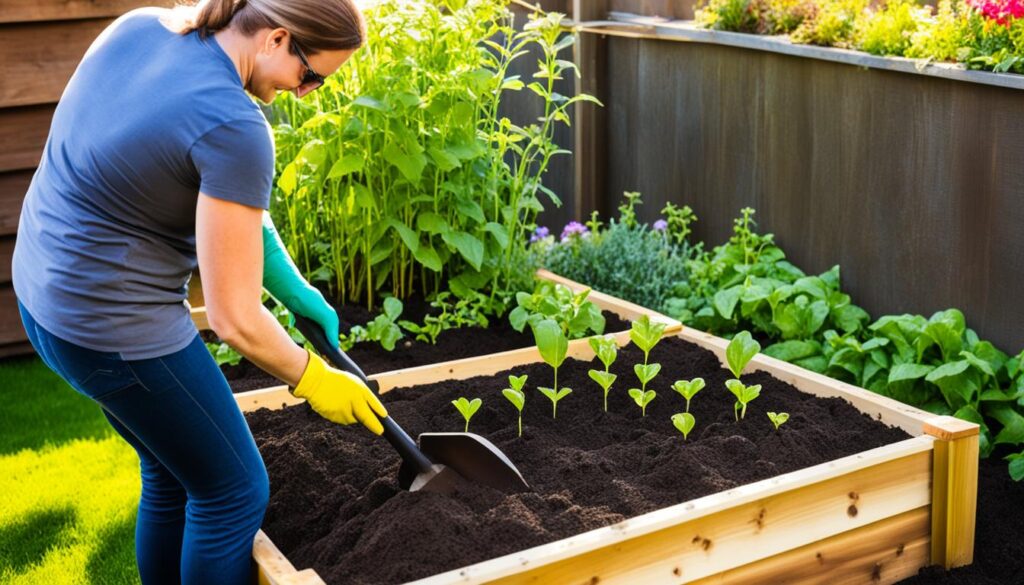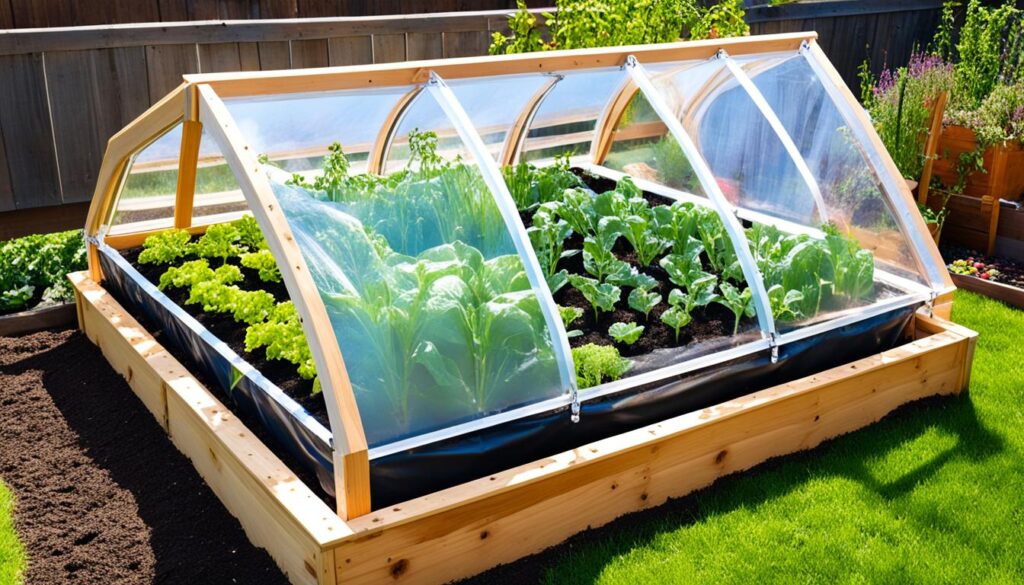Growing a lush and fruitful potted Meyer lemon tree can be a rewarding experience. However, if you’ve noticed your lemon tree dropping leaves, you may be wondering what’s causing this issue. Leaf drop in a potted Meyer lemon tree can be caused by various factors, including watering and moisture management, nutrient optimization, pest and disease management, and environmental conditions. Understanding these potential causes and implementing appropriate care techniques can help address the issue and promote a healthier plant.
Key Takeaways:
- Overwatering or underwatering can lead to leaf drop in potted Meyer lemon trees. Maintain proper soil moisture levels and establish a balanced watering routine.
- Nutrient deficiencies, such as nitrogen, potassium, and magnesium, can contribute to leaf drop. Fertilize with a balanced fertilizer and address specific deficiencies with appropriate supplements.
- Pests and diseases can also cause leaf drop. Regular inspection, pest control measures, and disease prevention techniques are key for managing these issues.
- Fluctuations in temperature and light can trigger leaf drop. Create a stable environment by maintaining consistent temperature, providing ample sunlight, and managing humidity and drafts.
- Lemon trees can be susceptible to various diseases, including anthracnose, Armillaria root rot, and citrus greening. Treating with appropriate fungicides and pruning diseased branches can help manage these diseases.
Watering and Moisture Management
One of the key factors that can contribute to leaf drop in potted Meyer lemon trees is improper watering and moisture management.
Overwatering is a common problem that can lead to the tree’s decline. If you notice that your potted lemon tree’s leaves are soft and limp, it could be a sign of overwatering. Conversely, underwatering can cause the leaves to become crispy and light.
To prevent leaf drop caused by watering issues, it’s important to check the soil moisture regularly. Insert your finger about an inch into the soil, and if it feels moist, hold off on watering. Only water when the top inch of the soil feels dry to the touch.
Establishing a balanced watering routine is crucial. Aim to provide enough water to thoroughly moisten the soil, but avoid overwatering, which can lead to root rot and other problems. It’s also essential to ensure proper drainage for your potted lemon tree. This can be achieved by ensuring there are drainage holes in the pot and using a well-draining potting mix.
By maintaining the right moisture level through proper watering and ensuring good drainage, you can help prevent leaf drop and promote the overall health of your potted Meyer lemon tree.
Nutrient Optimization
Nutrient deficiencies can be a major cause of leaf drop in Meyer lemon trees. It’s important to recognize the signs of these deficiencies and take steps to optimize the nutrient levels in your tree’s soil. This will help promote healthy leaf growth and prevent leaf loss.
Common Nutrient Deficiencies
There are several key nutrients that play a crucial role in maintaining the health of your Meyer lemon tree. Understanding these nutrients and recognizing their deficiencies is the first step in addressing the issue. The most common nutrient deficiencies in lemon trees include:
- Nitrogen (N)
- Potassium (K)
- Magnesium (Mg)
To diagnose a nutrient deficiency, you need to observe the symptoms exhibited by the leaves. Here are some common signs of nutrient deficiencies in Meyer lemon trees:
“The leaves of my Meyer lemon tree are turning yellow and falling off. They also appear to be light green in color, and some have brown spots.”
Fertilizing with a Balanced Fertilizer
Fertilizing your Meyer lemon tree with a balanced fertilizer is crucial for maintaining optimal nutrient levels in the soil. A balanced fertilizer contains a mix of essential nutrients, including nitrogen, potassium, and magnesium. It’s important to follow the package instructions and apply the fertilizer at the recommended rates to avoid over-fertilization, which can also harm the tree.
Soil Testing
Conducting regular soil tests is essential to determine the nutrient profile of your tree’s soil. Soil testing kits are readily available at garden centers or by sending samples to a laboratory. The results of the soil test will indicate the nutrient deficiencies present in the soil, allowing you to address them effectively.
Addressing Specific Deficiencies
In addition to using a balanced fertilizer, addressing specific nutrient deficiencies is crucial. This may involve applying targeted supplements to the soil to rectify deficiencies. For example, if your soil test reveals a magnesium deficiency, you can apply Epsom salt (magnesium sulfate) to provide the necessary nutrient to your Meyer lemon tree.
Attention to Micronutrients and Soil pH
While nitrogen, potassium, and magnesium are essential, it’s also important to pay attention to micronutrients, such as iron, zinc, and manganese. These trace elements are vital for overall tree health. Moreover, maintaining the appropriate soil pH is crucial for nutrient availability to the tree. A slightly acidic soil pH of 6.0 to 6.5 is optimal for Meyer lemon trees.
To ensure your Meyer lemon tree receives the necessary nutrients, consider incorporating compost and organic matter into the soil. These additions help improve soil fertility, nutrient retention, and overall plant health.
Summary
Optimizing nutrient levels in your Meyer lemon tree’s soil is key to preventing leaf drop. By recognizing the signs of nutrient deficiencies, fertilizing with a balanced fertilizer, conducting soil tests, addressing specific deficiencies, and paying attention to micronutrients and soil pH, you can ensure your lemon tree receives the proper nourishment it needs to thrive.
| Nutrient | Roles | Deficiency Symptoms |
|---|---|---|
| Nitrogen (N) | Stimulates leaf and stem growth | Yellowing leaves, stunted growth |
| Potassium (K) | Aids in fruit development and water regulation | Leaf edges turning brown, weak branches |
| Magnesium (Mg) | Essential for chlorophyll production | Interveinal yellowing, brown spots |
Pest and Disease Management
Pests and diseases are common culprits behind leaf drop in potted Meyer lemon trees. It’s important to regularly inspect your tree, take preventive measures, and address any issues promptly to maintain its health and minimize leaf drop.
Pest Control Measures
I highly recommend introducing natural predators, such as ladybugs or lacewings, to your garden. These beneficial insects feed on pests like aphids and scale insects, reducing their numbers and preventing damage to your lemon tree.
Alternatively, you can use insecticidal soap to target specific pest problems. This organic solution effectively controls pests without harming beneficial insects or the environment. Remember to follow the instructions on the product label for best results.
Proper Drainage and Mulching
Healthy drainage is essential for preventing disease in potted lemon trees. Ensure that your container has proper drainage holes to avoid waterlogged soil, as excess water can lead to root rot and other issues.
Add a layer of mulch around the base of your lemon tree. Mulch helps conserve moisture, regulate soil temperature, and suppress weed growth. Organic materials like wood chips or shredded leaves make excellent mulch options.
Fungicide Use
If your tree is affected by fungal diseases such as powdery mildew or citrus canker, using a suitable fungicide can help manage the issue. Choose a fungicide specifically formulated for citrus trees and follow the instructions carefully to effectively treat and prevent disease.
Pruning
Regular pruning is important for maintaining the overall health and shape of your potted Meyer lemon tree. It allows better airflow and sunlight penetration, reducing the risk of fungal infections and improving fruit production.
Remove any dead, damaged, or diseased branches to prevent the spread of pathogens. Always use clean and sharp pruning tools to make clean cuts and avoid damaging the tree further.
By implementing these pest and disease management techniques, you can protect your potted Meyer lemon tree from common issues and reduce leaf drop.

Common Pests and Diseases of Meyer Lemon Trees
| Pests | Symptoms | Treatment |
|---|---|---|
| Aphids | Sticky residue on leaves, distorted growth | Introduce ladybugs or use insecticidal soap |
| Scale Insects | Small bumps on stems and leaves, yellowing foliage | Introduce lacewings or use insecticidal soap |
| Whiteflies | Tiny white insects flying around the tree, sticky residue | Use sticky traps or insecticidal soap |
| Powdery Mildew | White powdery patches on leaves | Apply fungicide labeled for citrus trees |
| Citrus Canker | Brown lesions with corky edges on leaves and fruit | Prune affected branches, follow proper sanitation practices |
| Root Rot | Wilting, yellowing leaves, root discoloration | Improve drainage, repot in fresh soil if necessary |
Environmental Conditions
Fluctuations in temperature and light can trigger leaf drop in Meyer lemon trees. To prevent leaf drop and create a stable environment for your potted lemon tree, consider the following:
- Maintain a consistent temperature range: Meyer lemon trees thrive in temperatures between 50-80°F (10-27°C). Avoid exposing them to extreme temperature changes to prevent stress and leaf drop.
- Provide ample sunlight or use grow lights: Meyer lemon trees require at least 6-8 hours of direct sunlight daily. If you have limited sunlight indoors, supplement with grow lights to ensure your tree receives sufficient light.
- Manage humidity and drafts: Meyer lemon trees prefer moderate humidity levels between 40-60%. Avoid placing them near heaters, air conditioners, or drafty areas as these can cause fluctuations in humidity and temperature.
- Gradually transition between indoors and outdoors: When moving your potted lemon tree between indoor and outdoor environments, do it gradually over a week or two. Sudden changes in light, temperature, and humidity can shock the tree and lead to leaf drop.
By paying attention to these environmental conditions and providing optimal care, you can help your potted Meyer lemon tree thrive and maintain healthy foliage.

| Environmental Conditions | Effects on Leaf Drop |
|---|---|
| Temperature fluctuations | Stress and leaf drop |
| Insufficient sunlight | Reduced photosynthesis and leaf drop |
| High humidity | Predilection for fungal diseases and leaf drop |
| Drafts | Stress and leaf drop |
Disease Problems
Lemon trees, like all plants, are susceptible to various diseases that can lead to leaf drop. Understanding these diseases and their symptoms is crucial in managing them effectively and preventing further leaf drop. Here are some common diseases that can affect potted lemon trees:
Anthracnose: This fungal disease causes dark, sunken lesions on leaves, stems, and fruit. Infected leaves may drop prematurely.
Armillaria Root Rot: This fungal infection attacks the roots, causing them to rot. Affected trees may show signs of stunted growth, leaf drop, and dieback.
Bacterial Blast: This bacterial disease causes yellowing, wilting, and blackening of leaves, leading to leaf drop.
Botrytis Rot: Also known as gray mold, this fungal disease affects flowers, fruit, and leaves. Infected leaves may become discolored, wilted, and eventually drop.
Citrus Greening: This bacterial disease causes mottled, discolored leaves and can lead to premature leaf drop.
Greasy Spot: This fungal disease appears as oily, raised spots on the lower surface of leaves. Severely infected leaves may drop.
Mal Secco: This fungal disease causes yellowing, wilting, and leaf drop. Infected branches may also show dieback.
Phytophthora: This waterborne pathogen attacks the roots, leading to root rot. Infected trees may exhibit leaf drop and dieback.
Tristeza: This viral disease affects the vascular system of the tree, leading to leaf yellowing, stunting, and eventual leaf drop.
Recognizing the symptoms of these diseases is essential for timely intervention. Implementing integrated pest management strategies, such as proper pruning, removal of diseased branches, and using appropriate fungicides, can help manage these diseases and reduce leaf drop in potted lemon trees.

Common Diseases in Potted Lemon Trees
| Disease | Symptoms | Treatment |
|---|---|---|
| Anthracnose | Dark, sunken lesions on leaves, stems, and fruit | Prune affected parts, apply fungicides |
| Armillaria Root Rot | Stunted growth, leaf drop, dieback | Remove affected plants, improve drainage |
| Bacterial Blast | Yellowing, wilting, blackening of leaves | Prune affected parts, apply copper-based sprays |
| Botrytis Rot | Discolored, wilted leaves; fruit and flower rot | Remove infected plant material, improve air circulation |
| Citrus Greening | Mottled, discolored leaves; stunted growth | Remove infected plants, control insect vectors |
| Greasy Spot | Oily, raised spots on the lower leaf surface | Prune affected parts, improve air circulation |
| Mal Secco | Yellowing, wilting, leaf drop; branch dieback | Prune affected parts, apply fungicides |
| Phytophthora | Root rot, leaf drop, dieback | Improve drainage, apply fungicides |
| Tristeza | Leaf yellowing, stunting, leaf drop | Remove infected plants, control aphid vectors |
Pest Problems
When it comes to potted lemon trees, dealing with pest problems is crucial to prevent leaf drop. Insect infestations, such as citrus rust mites and soft scales, can wreak havoc on your lemon tree, causing premature leaf drop and compromising its overall health.
To combat these pests effectively and minimize leaf drop, I recommend using two powerful weapons – insecticidal soap and horticultural oils. These natural remedies are safe to use and provide excellent control over common pests infesting lemon trees.
Citrus rust mites: These tiny pests cause significant damage to lemon trees, feeding on the leaves and affecting their overall vitality. To eliminate them, mix a solution of insecticidal soap according to the package instructions. Apply the solution to the affected areas of the lemon tree, ensuring thorough coverage. Repeat the application every two weeks or as needed until the infestation is under control.
Soft scales: Soft scales are another common pest that can cause leaf drop in lemon trees. These small, oval-shaped insects attach themselves to the tree’s leaves and stems, sucking out the sap and weakening the plant. To get rid of them, mix horticultural oil with water as per the product instructions and spray it directly on the affected areas. The oil will smother the scales, preventing further damage to the lemon tree.
Remember to regularly inspect your potted lemon tree for signs of pest infestation and take immediate action if you notice any. Early detection and intervention are crucial in preventing extensive leaf drop and maintaining the health of your lemon tree.
| Pest | Identification | Treatment |
|---|---|---|
| Citrus rust mites | Tiny pests that cause damage to leaves | Insecticidal soap application every two weeks or as needed |
| Soft scales | Small, oval-shaped insects that feed on sap | Horticultural oil spray directly on affected areas |
Nutrient Problems
When it comes to caring for a potted Meyer lemon tree, nutrient imbalances can contribute to leaf drop. Two common culprits are boron toxicity and sodium toxicity. These nutrient problems can disrupt the tree’s overall health and cause leaves to drop prematurely.
To prevent nutrient-related leaf drop, it’s important to monitor fertilizer application and recognize the symptoms of nutrient issues. Adjusting the fertilizer type and amount based on the tree’s needs can help restore the balance and promote healthier foliage.
Here are some signs of nutrient problems to watch out for:
- Discoloration or yellowing of leaves
- Stunted growth or smaller leaf size
- Leaf curling or distortion
- Poor fruit development
If you notice any of these symptoms in your potted lemon tree, it’s essential to take action. Testing the soil pH and nutrient levels can provide valuable insights and guide your nutrient management plan. Consulting with a local horticulture expert or contacting your nearest agricultural extension office can also be helpful in identifying and addressing specific nutrient deficiencies.
Remember, maintaining a balanced nutrient profile is crucial for the overall health and vitality of your potted Meyer lemon tree. Providing the right nutrients in the right amounts will ensure that your tree can thrive and produce delicious lemons.
Common Nutrient Deficiencies in Meyer Lemon Trees
| Nutrient Deficiency | Symptoms | Treatment |
|---|---|---|
| Nitrogen | Pale yellow leaves, slow growth | Fertilize with nitrogen-rich fertilizer |
| Potassium | Leaf margins turn brown, poor fruit quality | Fertilize with potassium-rich fertilizer |
| Magnesium | Yellowing between veins, leaf drop | Fertilize with magnesium sulfate (Epsom salt) |
| Iron | Yellowing leaves with green veins | Fertilize with iron chelate |
Regularly monitoring and addressing nutrient problems will ensure that your potted Meyer lemon tree remains healthy and vibrant, with a lush canopy of leaves.
Environmental Problems
When it comes to potted lemon trees, environmental factors can play a significant role in leaf drop. Changes in light and temperature, as well as hail damage, can all contribute to this issue. To prevent leaf drop caused by environmental stressors, it’s important to pay attention to a few key considerations.
First, proper positioning of your lemon tree is crucial. Make sure it is placed in a spot that receives adequate sunlight throughout the day. If necessary, you can supplement with artificial grow lights to ensure your tree gets the light it needs.
Additionally, when transitioning your potted lemon tree between indoor and outdoor environments, it’s essential to do so gradually. Sudden changes in temperature can shock the tree and lead to leaf drop. Gradually acclimating it to its new surroundings will help minimize stress and leaf loss.
Lastly, protecting your lemon tree from extreme weather conditions, such as hail, can also help prevent leaf drop. If hail damage occurs, promptly address any affected areas and provide necessary care to promote the tree’s recovery.








